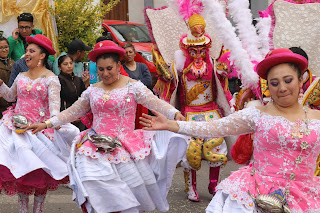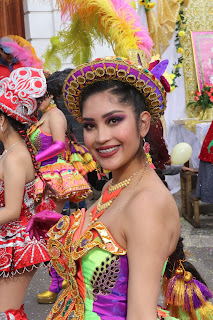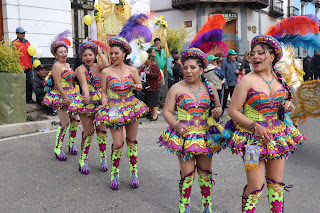Now
Uyuni has been given a fairly bad press in the Rough Guide, it talks about it
being scruffy and with little to recommend it, but this was not what we
found. We found a vibrant bustling sort
of place, bands playing loudly and enthusiastically, and markets all over with
a lot of people in traditional dress.
Municipal band at Uyuni
Country woman at her market stall
Country woman at market
Country woman with sickles
In its
heyday Uyuni was the main gateway to the outside world as it was at the
junction of the railways that enter Bolivia from both Chile and Argentina. There are several very large old locomotives
housed in the town’s Museo Ferrocarril and, on the edge of town is the Train
Cemetery. Here we found a graveyard of rusting steam engines, passenger
carriages and freight wagons, a rather sad monument to the golden age of steam.
It still appears to have its uses though, mainly for graffiti artists, the
local bird population as handy nest sites and the local tourists as handy
places to pose. (Incidentally, one tourist lost his footing about three weeks
ago, fell off the top of one of the engines and broke his neck and killed
himself).
Old Engines in the museum
Old engine in the museum
Train Cemetery
Final resting place
This train ain't going anywhere
Nor is this one
Our
main reason for staying at Uyuni, however, was to visit the nearby Salar de
Uyuni, the world’s largest salt lake. We were advised to travel very slowly
across the salt and in convoy with the multitude of tourist vans that would be
doing the same thing because if you get off the safe route your vehicle is very
likely to get very stuck.
We had
a little squabble about whether we should or should not go a bit off piste (no
prizes for guessing who wanted to go off-piste) but we stayed on piste and went
as far as a semi derelict hotel built of salt right out on the Salar. The dazzling salt surface was so intensely
white that it looked more like snow or ice, and it was an experience we both
enjoyed immensely.
On the salt flat with model sized Lucy
Miles and miles of salt
Big show off on the salt flat
Our
lovely hotel was immediately next to the army barracks which was unusually
situated in the centre of town. Throughout our stay (sometimes at six in the
morning) we were frequently disturbed by the sound of the army marching around
the town, led by its extremely loud oompah band. When we enquired whether they did this every
day, having nothing better to do, we were told that it was the anniversary of
having lost the War of the Pacific with Chile.
One wonders how long the celebrations would have gone on if they had won
the war!
Having
visited the largest salt lake in the world, on Sunday 24th March we
left Uyuni and drove to Potosi, the highest city in the world, over 4,000
metres high, very steep and with lots of interesting colonial buildings.
Children's demonstration against loss of Bolivia's coastline
Protest poster carried by uncomprehending child
The
drive over the Altiplano was brilliant, lots of different geography to look at,
twisted and turned strata walls sticking out of the native rock, vast green
valleys and huge herds of llama, also cattle and some sheep and higher up the
constant presence of small herds of vicuna dancing along through the rocks and
vegetation.
There
was a lot of oompahing going on just after we arrived in Potosi and, when we
enquired, we were told it was the Fiesta of San Juan, so we went to have a
look. What a fiesta! First of all, there were a number of pious
looking men carrying life size effigies of J.C. and then one presumably of San
Juan who looked as though he had an advanced case of piles from the anguished
expression on his face.
Vicuna drinking at water hole, Altiplano
Llama on the Altiplano
Donkeys on the Altiplano
Fiesta of San Juan, the religious bit
After
that the fun started. There were at
least six bands, all equipped with huge bass drums, trumpets, cornets,
trombones and of course sousaphones, each band followed by groups of
dancers.
Tuba player
Sousaphones
Female cymbal player being noticed
Trumpeter giving it his all
Banging the big bass drum
All the fun of the fiesta
Assortment of dancers
Assortment of dancers
Male and female dancers
Male and female dancers
The
male dancers were dressed in a variety of very elaborate costumes and masks,
some of which appeared to be representative of conquistadors with the curly
Spanish helmets and fierce red faces, others of which were more abstract and
representative of various diabolical figures.
Most of the men were drinking and some of them were quite drunk but
happy drunk so that they were standing there, swaying gently in the breeze
trying to keep pace with the music and the other dancers and often being
assisted by friends in the crowd.
Conquistador dancer
Scary male dancer
Scary male dancer
Male dancers in step
Grotesque male dancers
Grotesque male dancers with armadillo head-dresses
Male dancer with beer in hand
Male dancer, the worse for wear
Taking a breather
Head-dress back on
How much further?
That was the men. The women were not dressed up in big costumes, in fact the women were mostly dressed in as little as possible, but they were statuesque, and their costumery involved five inch glitter clad boots, the skimpiest of dresses, long silver or metallic red, pink or blue gloves, hats with swaying feathers and they were all dancing along in perfect unison to the sound of the bands. Alan said that he has never seen such an overt display of sexuality in his life and it was great!
Now the lovely female dancers
Rear view
Mature ladies with skirts in full swing
Enjoying a small libation
And the older ladies take part too
Much older lady dancing and swinging a rattle
The
other really memorable part of our visit to Potosi was a trip to one of the
mines, the mines being the silver mines of Cerro Rico, a mountain which rises
imperiously above the city. In the 17th
century Cerro Rico was the richest source of silver in the world and made
Potosi one of the largest and wealthiest cities in the world. However, this wealth was achieved at the
expense of the lives of millions of indigenous forced labourers and African
slaves, around eight million in a two hundred year period.
Inside Potosi Cathedral
View of Cerro Rico from Cathedral Tower window
Sue making like Liberace
View from Cathedral bell tower
View of Cerro Rico from Bell Tower
View of Potosi from Bell Tower
Very heavy bell held up with Llama hide
Main door to the Casa Real de la Moneda (Royal Mint)
Doleful Saint - Painting inside the Royal Mint (now a museum)
Holy Family with Cherubs, inside the Royal Mint
Miners' Market - get your lovely dynamite here
Street Vendor - Miners' Market
Sue in full mining kit
Entrance to mine
El Tio
Going
further down, and with Alan bouncing his head off the walls of the gallery a
little bit like a billiard ball, we came to a place where there were some
workings. These workings were much lower
down than the gallery we were in and they were accessed down a steep hole in
which the miners were hacking away at the rock that had recently been blasted
out from the wall.
Every
bit of rock came up to the surface in a bucket with a sort of a windlass to
carry it to the gallery level and then this was offloaded into a wheelbarrow
and taken out to the daylight and into a waiting lorry. Each wheelbarrow load apparently weighs up to
about 150 kilos or 23.5 stones!
Mineral ore being taken by wheelbarrow out of the mine
Miner pausing for a rest
Mineral ore being loaded onto truck
Pedro
told us they were about to do some shot firing and so we ought to move back up
the gallery a little which we did. Five
or six sticks of dynamite made a fine booming noise and shock waves came up the
gallery, closely followed by a large cloud of noxious dust.
It
seemed to us that this is a very hard way to earn a living. It’s dark, it’s dirty, it’s dangerous and
amazingly physically demanding. Life
expectancy in the mines is about fifteen years with most miners falling victim
to the deadly lung disease silicosis, or to accidents. Alan was particularly moved by our brief visit
and said he felt a camaraderie and a pride amongst the miners which is similar
to that which one experienced in the coalfields of Yorkshire.
Alan emerging from the mine
Campesinos in conversation, Potosi Plaza
Street scene, Potosi
Country women in conversation
We
would not have missed our visit to Potosi for anything but after nearly three
days above 4,000 metres we were quite relieved to leave and descend to an
altitude where we could breathe more normally.
Sucre, where we are now, is at a much more comfortable altitude of 2,800
metres.












































































